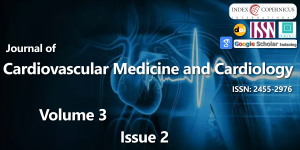Clinico-Etiological Profile of Cardiac Tamponade in a Tertiary Care Centre
Main Article Content
Abstract
Background: Pericardial tamponade, a life-threatening condition caused by the accumulation of fluid in the pericardial sac, can be acute or chronic. Mortality and morbidity can be minimized on prompt diagnosis and treatment with percutaneous drainage.
Materials and methods: 246 patients admitted with cardiac tamponade between Jan 2010 and Aug 2014 was enrolled in the study. After clinical examination and echocardiographic assessment, all the patients were subjected to emergency pericardiocentesis (both diagnostic and therapeutic). Three samples of the aspirate were sent for biochemical, serological, and cytological analysis. The data collected was then analyzed.
Results: Tuberculosis is the commonest cause in our study. Post procedural and post-surgical causes are insignificant in numbers. Overall mortality rate in our study is 6% which is much lesser than other studies. Procedure related cardiac tamponade mortality rate was 6%.
Conclusion: Initial assessment with clinical, serologic, and echocardiographic investigation and careful follow-up can in most cases yield a causal diagnosis. The prognosis depends chiefly upon the patient’s underlying disease.
Downloads
Article Details
Copyright (c) 2016 Nataraj Setty HS,et al.

This work is licensed under a Creative Commons Attribution 4.0 International License.
Spodick DH (1998) Pathophysiology of cardiac tamponade. Chest 113: 1372-1378 .
Costa IVI, Soto B, Diethelm L, Zarco P (1987) Air pericardial tamponade. Am J Cardiol 60: 1421-1422 .
Starling EH (1987) Some points on the pathology of heart disease. Lancet 652-655.
Collins D (2004) Aetiology and Management of Acute Cardiac Tamponade. Critical care and Resuscitation 6: 54-58 .
MM Le Winter (2008) Pericardial disease, in Braunwald’s Heart disease. Text book of cardiovascular medicine, P Libby, RO Bonow, DL Mann, Eds., Chapter70, 1851-1888, Saunders Elsevier, Philadelphia, Pa, USA, 8th edition, 2008.
Beck CS (1935) Two Cardiac Compression triads. JAMA 104: 714-716 .
Salem K, Mulji A, Lonn E (1999) Echocardiographically guided pericardiocentesis - the gold standard for the management of pericardial effusions and cardiac tamponade. Can J Cardiol 15: 1251–1255 .
Fontanelle LJ, Cuello L, Dooley BN (1971) Subxiphoid pericardial window. A simple and safe method for diagnosing and treating acute and chronic pericardial effusions. Thorac Cardiovasc Surg 62: 95–97 .
Alcan KE, Zabetakis PM, Marino ND, Franzone AJ, Michelis MF, et al. (1982) Management of acute cardiac tamponade by subxiphoid pericardiotomy. JAMA 247: 1143–1148 .
Kopecky SL, Callahan JA, Tajik AJ, Seward JB (1986) Percutaneous pericardial catheter drainage: report of 42 consecutive cases. Am J Cardiol 58: 633–635 .
Markiewicz W, Barovik R, Ecker S (1986) Cardiac tamponade in medical patients: treatment and prognosis in the echocardiographic era. Am Heart J 111: 1138–1142 .
Wong B, Murphy J, Chang J, Hassenein K, Dunn M (1979) The risk of pericardiocentesis. Am J Cardiol 4: 1110–1114 .
Salem K, Mulji A, Lonn E (1999) Echocardiographically guided pericardiocentesis - the gold standard for the management of pericardial effusions and cardiac tamponade. Can J Cardiol 15: 1251–1255 .
Kronzon I, Cohen ML, Winer HE (1983) Diastolic atrial compression; a sensitive echocardiographic sigh of cardiac tamponade. J Am Coll Cardiol 2: 770-775 .
Armstrong WF, Schilt BF, Helper DJ, Dillon JC, Feigenbaum H (1982) Diastolic collapse of the right ventricle with cardiac tamponade; an echocardiographic study. Circulation 65: 1491-1496 .
Soler-Soler J, Sagrista-Sauleda J, Prmanyer-Miralda G (2001) Management of pericardial effusion. Heart 86: 235-240 .
Maisch B, Ristic AD (2001) Practical aspcts of the management of pericardial disease. Heart 89: 1096-1103 .
Setty NS, Sadananda KS, Nanjappa MC, Patra S, Basappa H, et.al. (2014) Massive Pericardial Effusion and Cardiac Tamponade Due to Cholesterol Pericarditis in a Case of Subclinical Hypothyroidism-A Rare Event. J Am Coll Cardiol 63: 1451 .
Tsang TS, Enriquez-Sarano M, Freeman WK, Barnes ME, Sinak LJ, et al. (2002) Consecutive 1127 therapeutic echocardiographicaly pericardiocentesis: clinical profile, practice patterns, and outcomes spanning 21years. Mayo clinic proceedings 77: 429-436 .
Colombo A, Olson HG, Egan J, Gardin JM (1988) Etiology and prognostic implications of a large pericardial effusion in men. Clin Cardiol 11: 389–394 .





